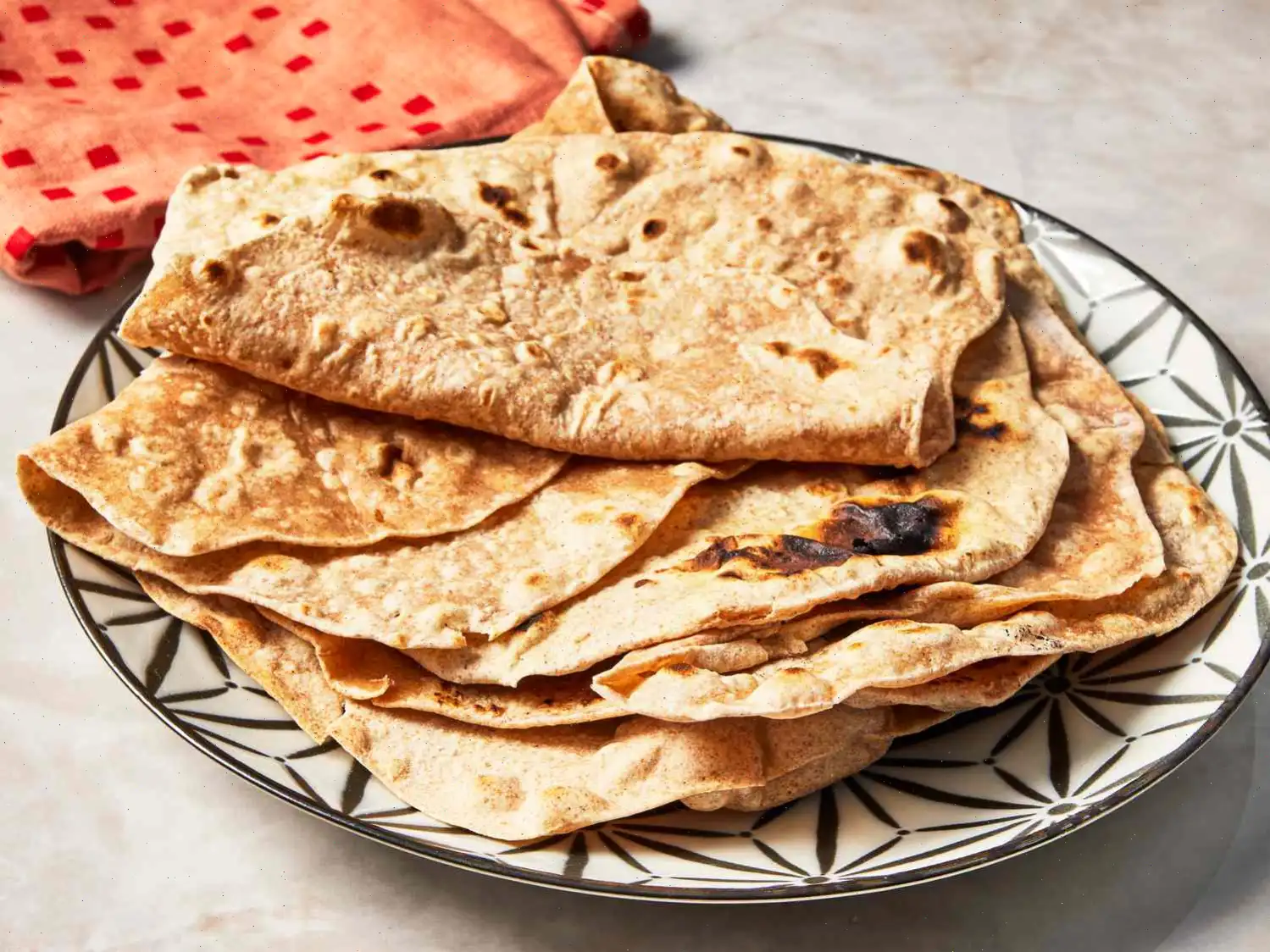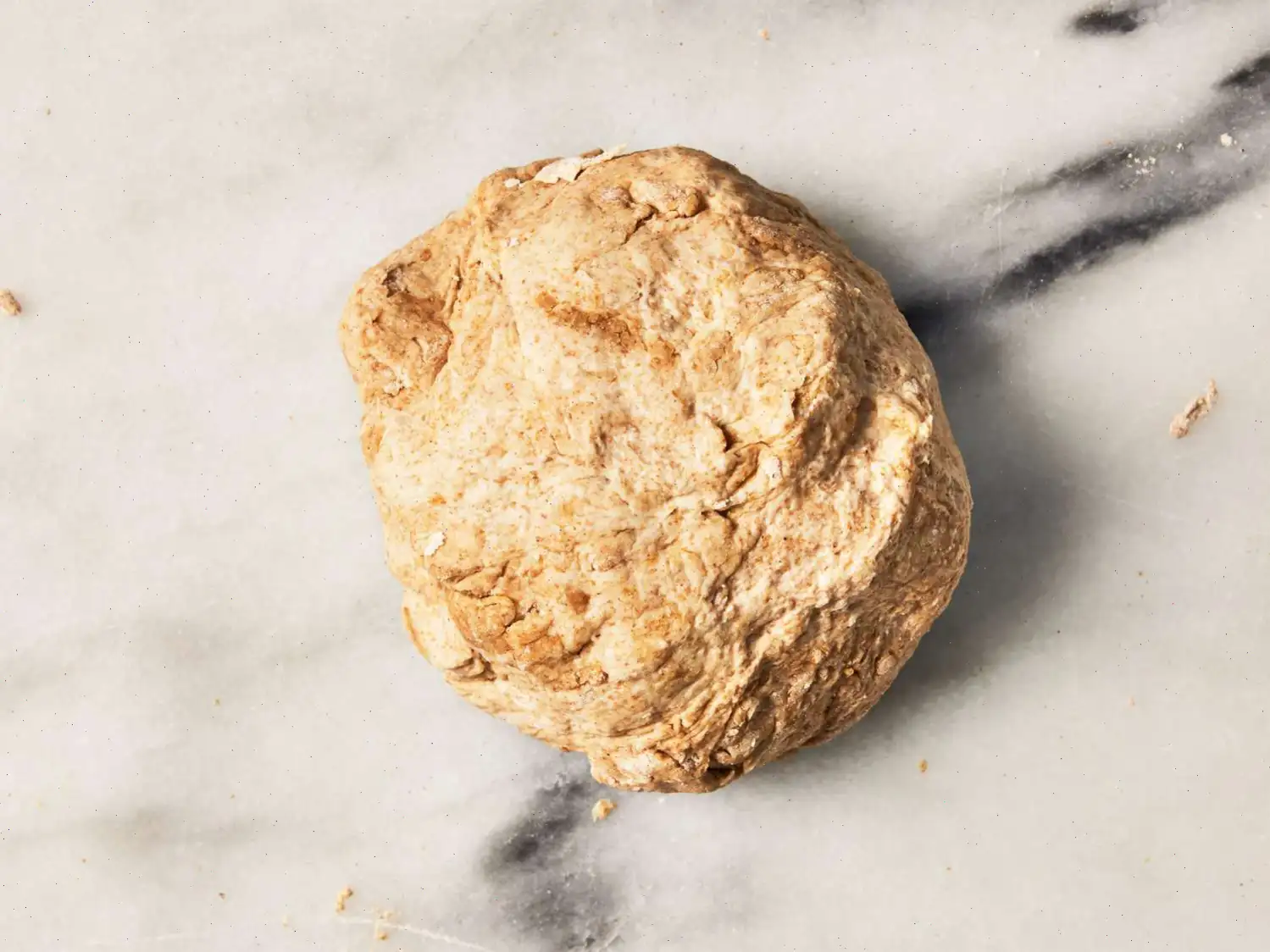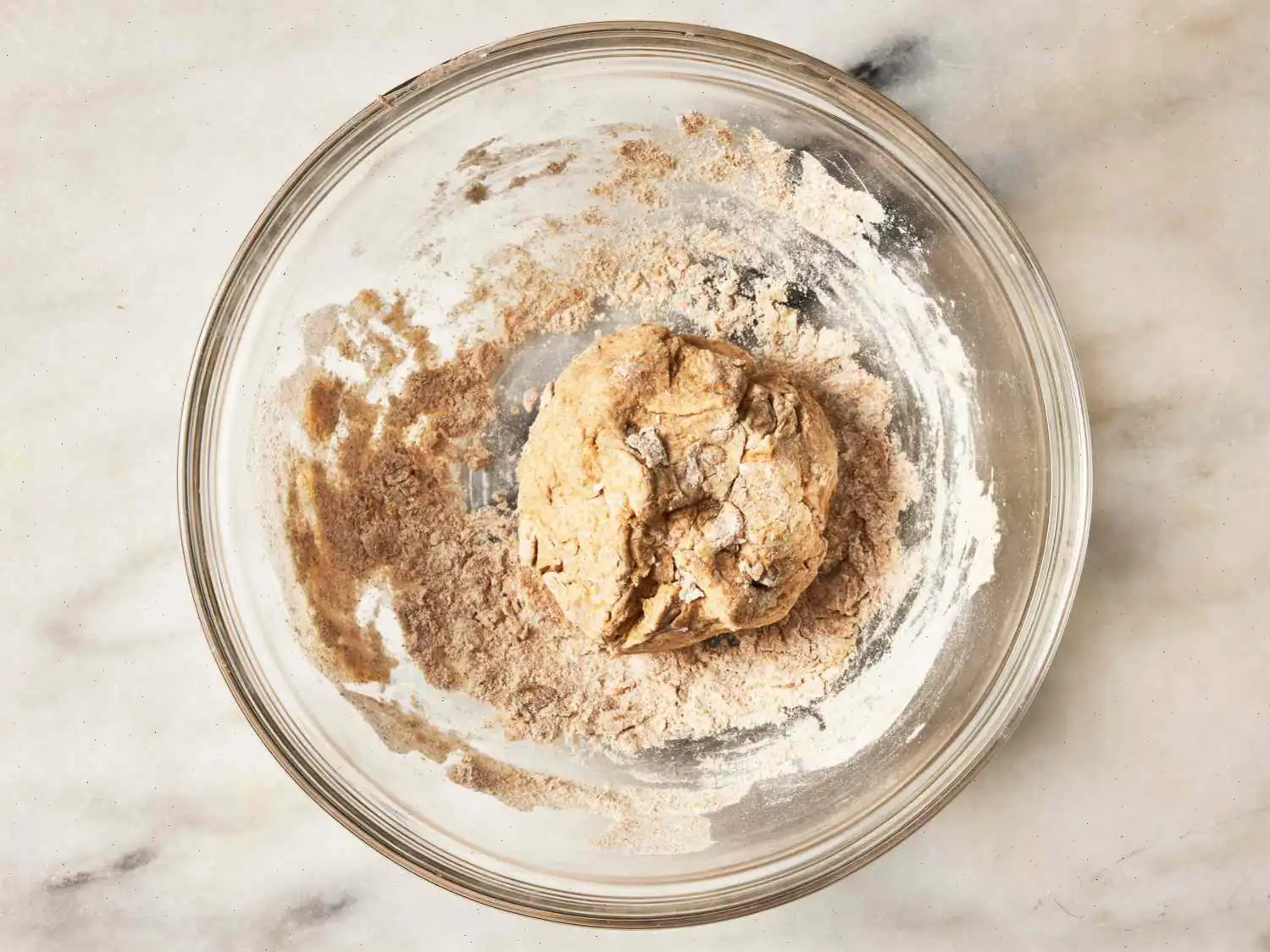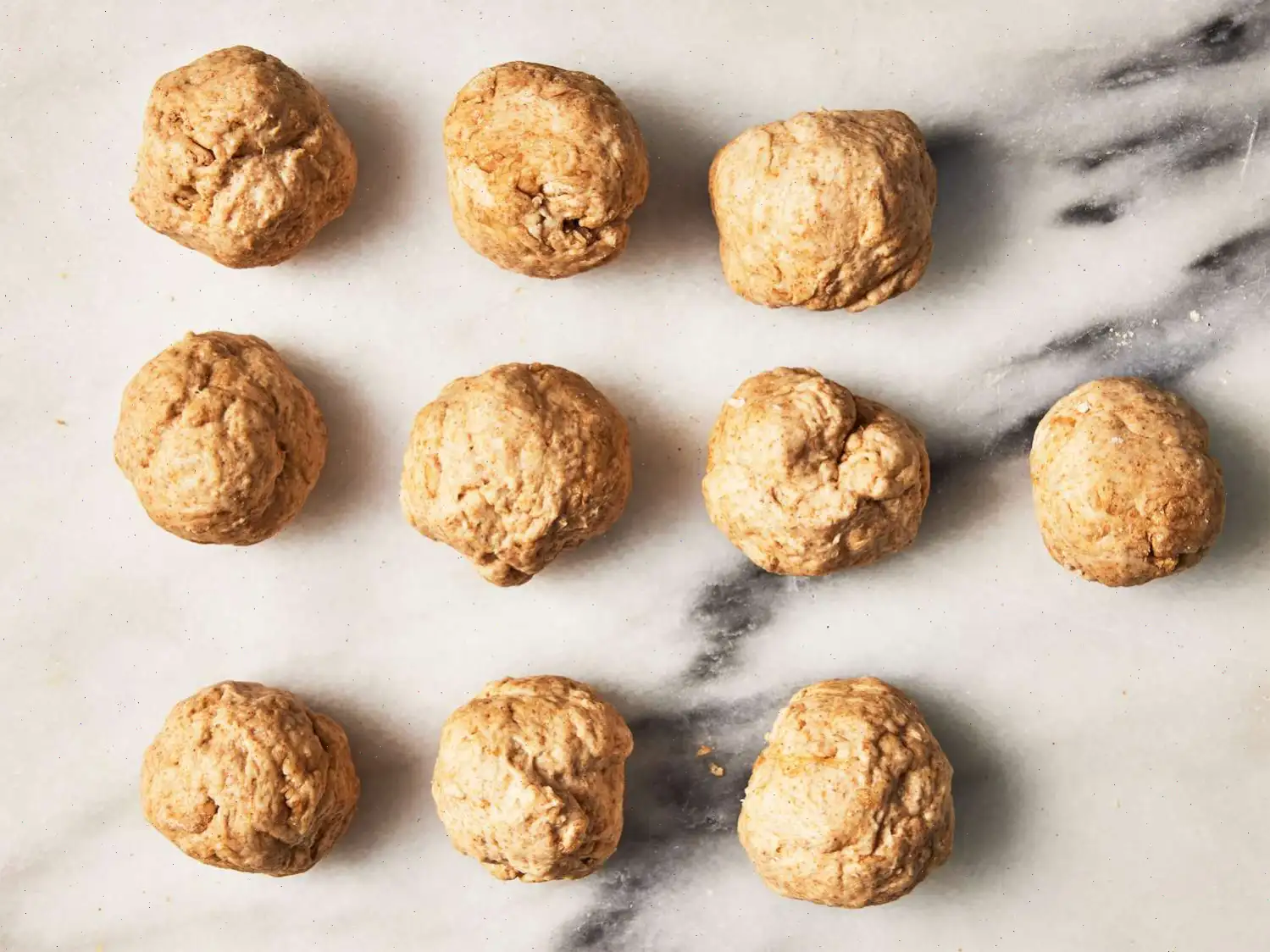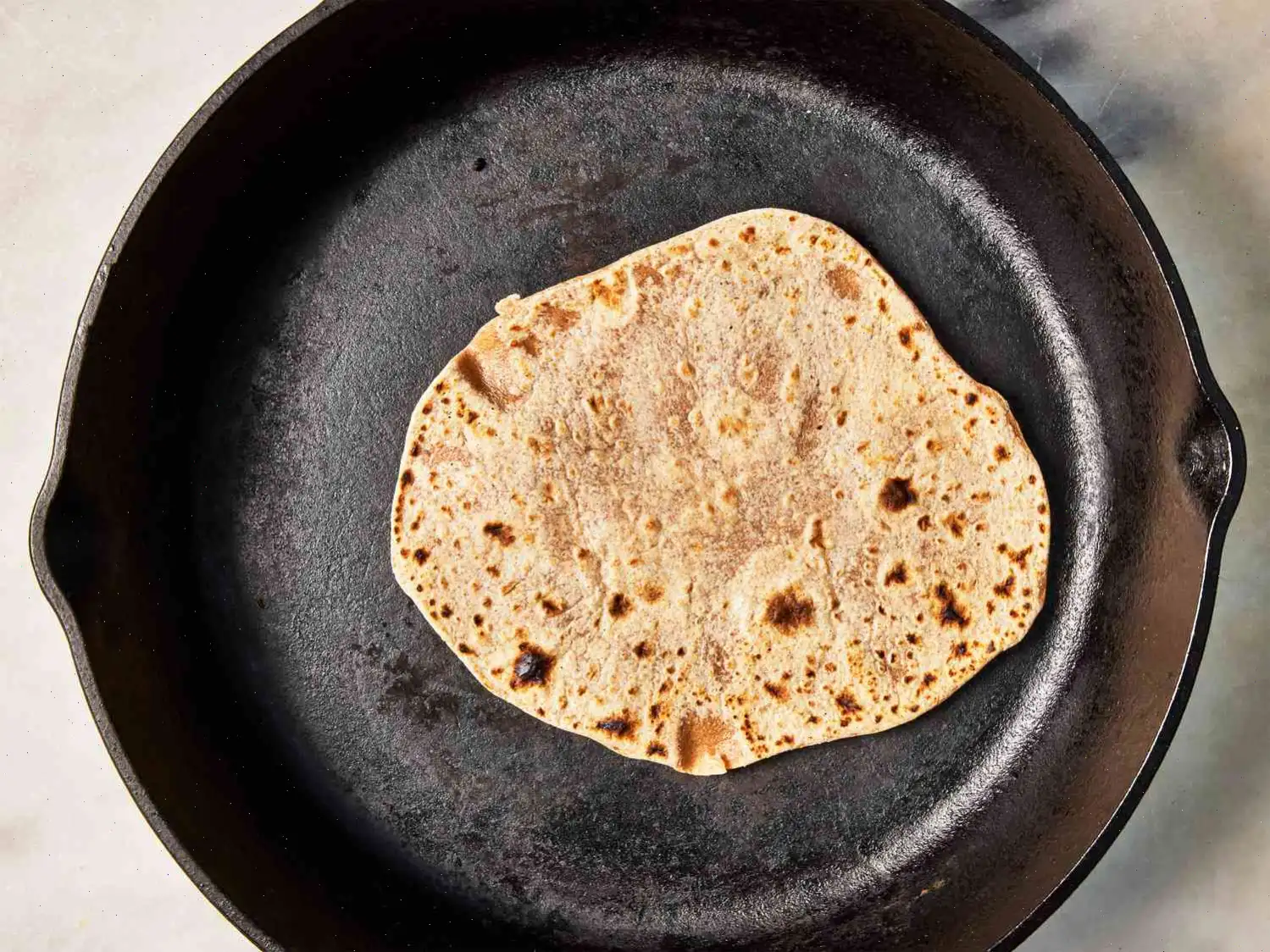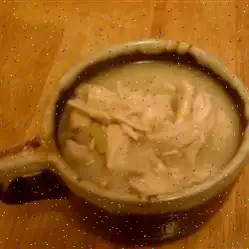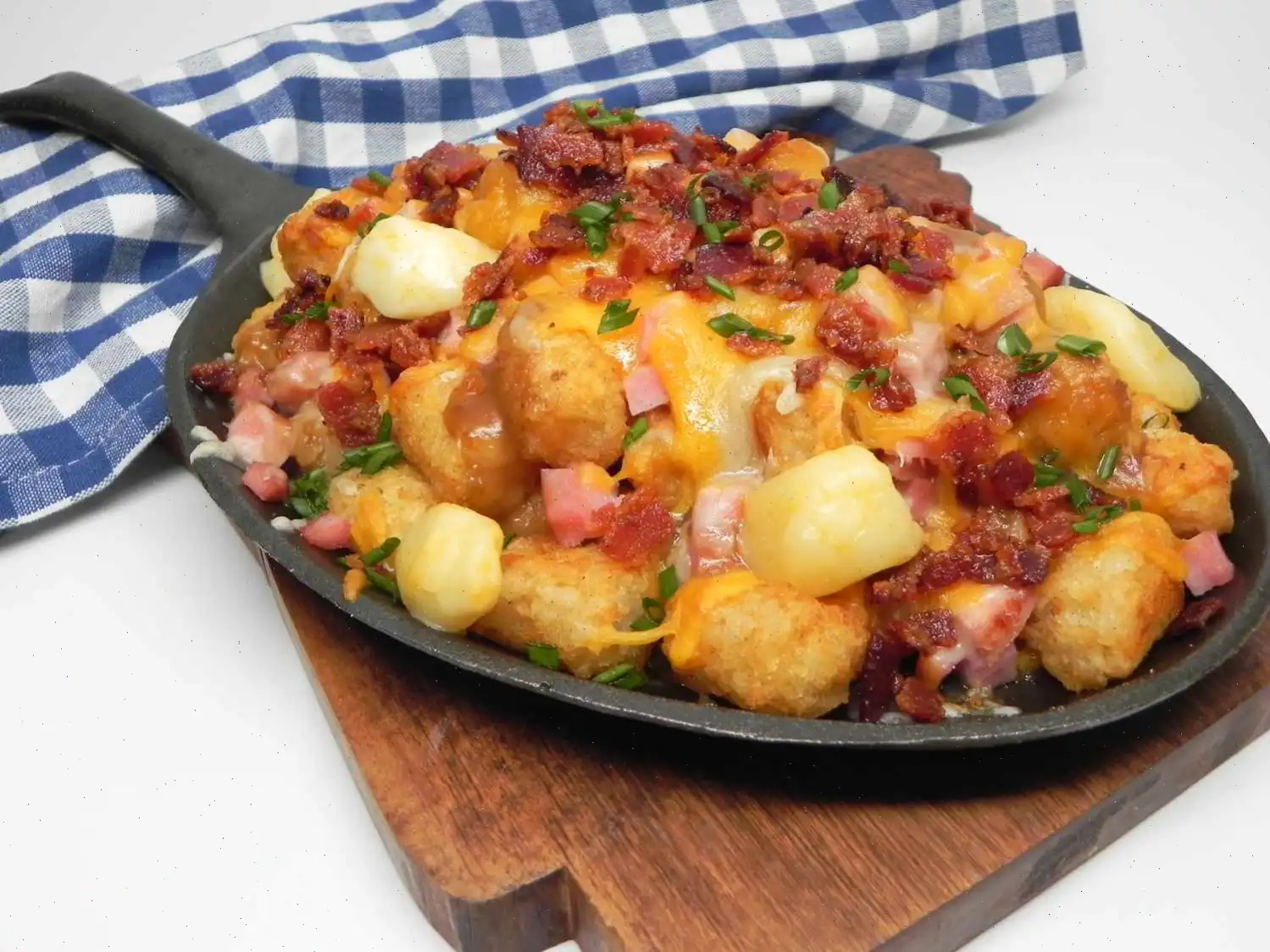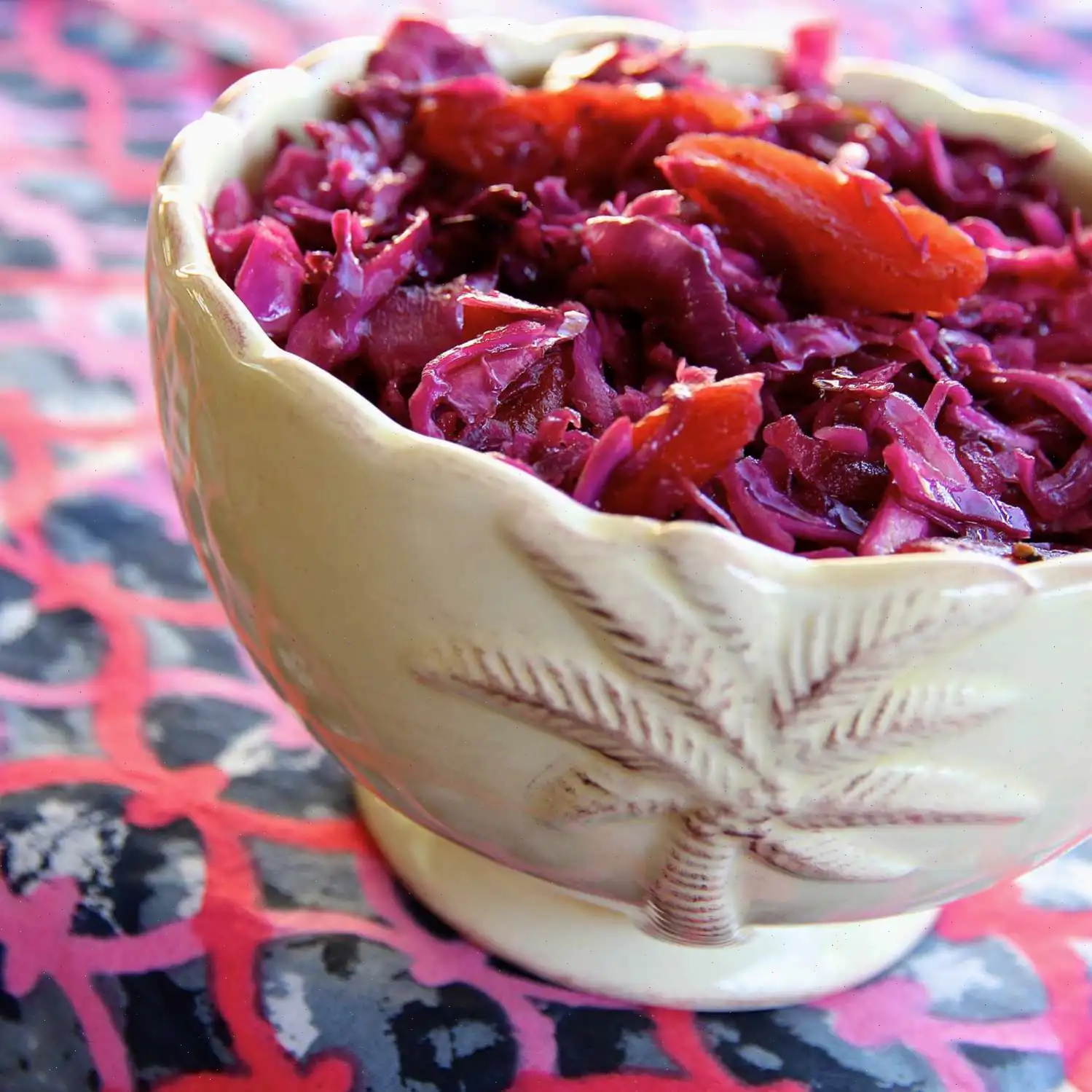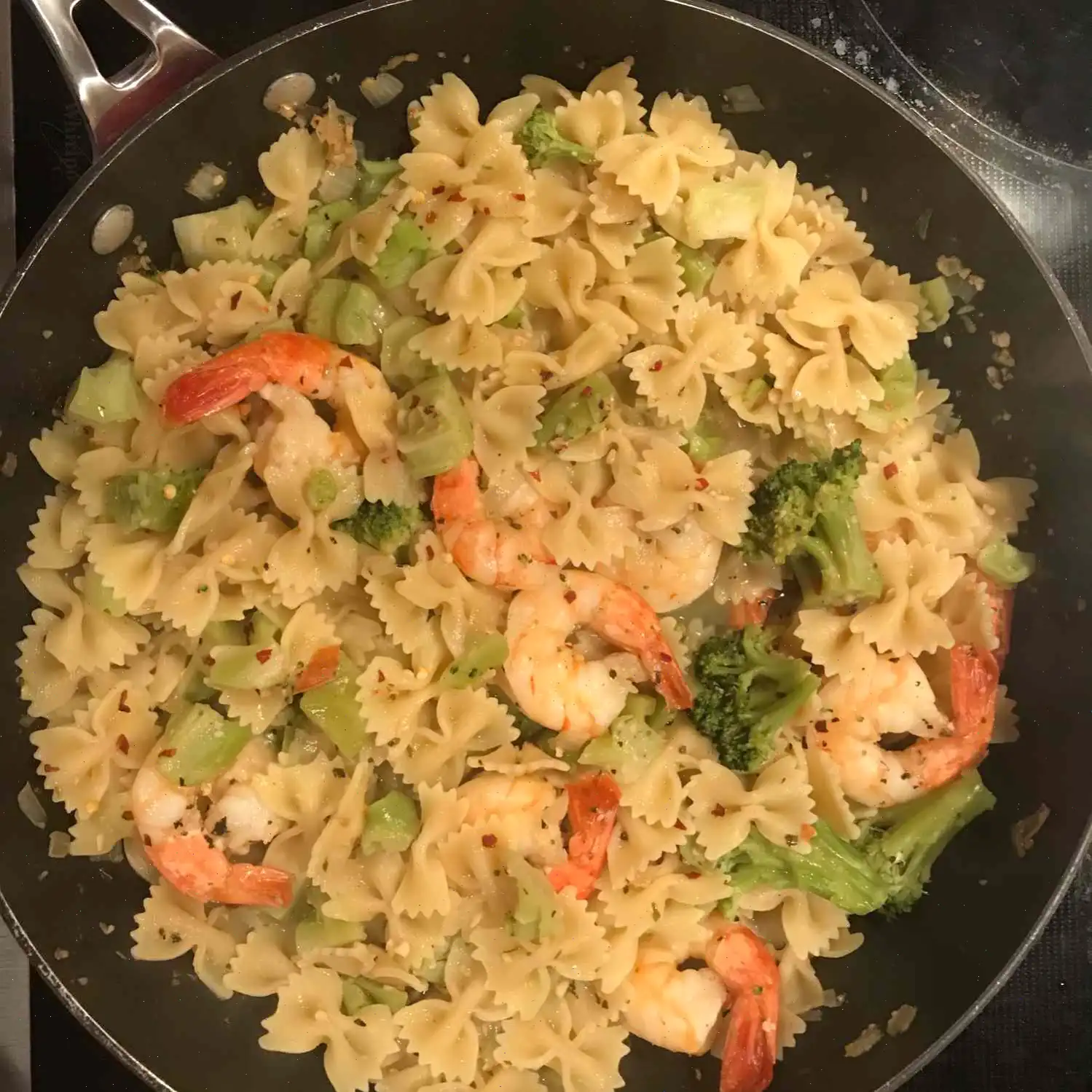
Indian Chapati Bread Recipe
Chapati Recipe
Ingredients
This recipe yields 10 servings.
- 1 cup whole wheat flour
- 1 cup all-purpose flour
- 1 teaspoon salt
- cup hot water (or as needed)
- 2 tablespoons olive oil or vegetable oil
Directions
- Prepare the ingredients: Gather all the ingredients needed for the recipe.
- Mix the dry ingredients: In a large bowl, combine whole wheat flour, all-purpose flour, and salt.
- Add wet ingredients: Use a wooden spoon to stir in the hot water and oil. Mix until a soft, elastic dough forms, adding more water if necessary to achieve the right consistency.
- Knead the dough: Transfer the dough onto a lightly floured surface and knead it until it becomes smooth and elastic.
- Divide the dough: Split the dough into 10 equal portions. You can make fewer portions if you prefer larger chapatis. Roll each portion into a ball and let them rest for a few minutes.
- Heat the skillet: Place a skillet on medium heat and lightly grease it with oil.
- Roll out the dough: Take each dough ball and roll it out using a rolling pin on a lightly floured surface until it's very thin.
- Cook the chapati: Once the skillet starts to smoke, place a chapati on it. Cook for about 30 seconds until the bottom has brown spots, then flip it and cook for another 30 seconds.
- Repeat: Repeat the process with the remaining dough balls, cooking each chapati the same way.
Nutrition Facts
Per Serving (1 Chapati):
| Calories | 110 |
|---|---|
| Total Fat | 3g (4% Daily Value) |
| Saturated Fat | 0g (2% Daily Value) |
| Sodium | 234mg (10% Daily Value) |
| Total Carbohydrates | 18g (7% Daily Value) |
| Dietary Fiber | 2g (6% Daily Value) |
| Total Sugars | 0g |
| Protein | 3g (6% Daily Value) |
| Calcium | 7mg (1% Daily Value) |
| Iron | 1mg (6% Daily Value) |
| Potassium | 62mg (1% Daily Value) |
Note: Percent Daily Values are based on a 2,000 calorie diet. Your daily values may be higher or lower depending on your calorie needs.
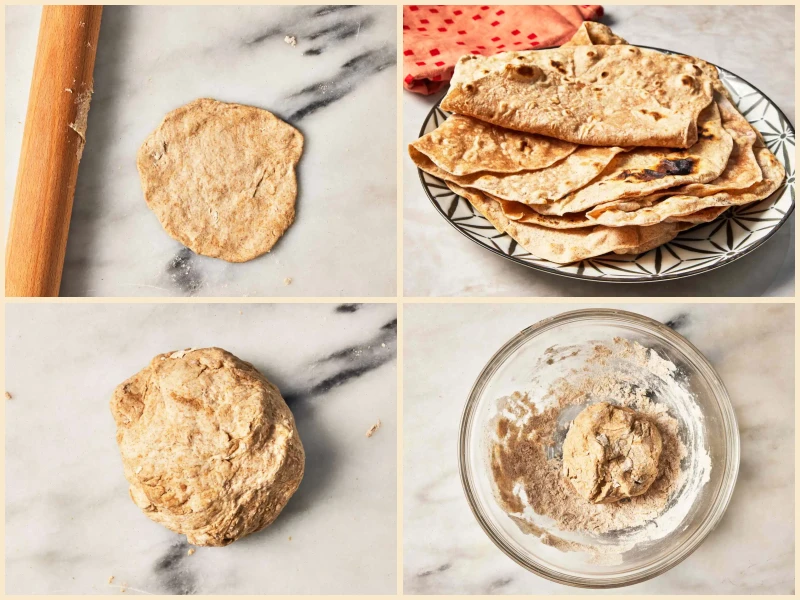
Chapati, a traditional Indian flatbread, has become a staple in many households not only across India but around the world. This simple yet delicious bread is made from a few pantry ingredients: wheat flour, water, salt, and oil. It is typically cooked on a flat skillet, known as a tawa, and is an essential part of Indian cuisine.
History of Chapati
The origin of chapati can be traced back to the Indian subcontinent, where it has been a fundamental food for thousands of years. The word "chapati" comes from the Hindi word "chapat," which means "flat." In ancient times, chapati was made using whole wheat flour, which was easily available and affordable for many families. It became a staple in the Indian diet because it could be prepared quickly and served with almost any dish, making it a versatile accompaniment. Over the centuries, different regions in India adapted the recipe based on local ingredients and cooking methods, leading to variations in its preparation.
Regional Variations
While chapati is popular throughout India, its preparation and characteristics can vary depending on the region. In northern India, chapatis are often made with a blend of whole wheat flour and white flour (maida), resulting in a softer texture. In contrast, in southern India, chapatis are typically made from whole wheat flour alone and tend to be slightly firmer. In some areas, especially in Gujarat and Rajasthan, you may find chapatis that are stuffed with ingredients like potato or paneer, giving the bread a more substantial flavor. The use of ghee (clarified butter) to cook chapatis is also common in some regions, imparting a rich flavor and soft texture.
Differences from Similar Dishes
Chapati is often compared to other flatbreads like naan and roti. The main difference lies in the ingredients and preparation methods. Unlike naan, which uses yeast or yogurt for leavening, chapati is unleavened, meaning it does not rise before cooking. Naan is typically baked in a tandoor (clay oven), whereas chapatis are made on a stovetop griddle. While both are delicious, chapati tends to be thinner and crispier compared to the fluffier naan. Roti, on the other hand, is a term that is often used interchangeably with chapati, though in some parts of India, roti can refer to a thicker, slightly softer version of chapati.
Where Chapati is Typically Served
Chapati is traditionally served with a wide variety of Indian dishes. It is commonly paired with lentils (dal), curries, vegetables, and meats. In many households, chapati is considered an essential part of the meal and is eaten alongside other dishes to scoop up sauces or to wrap around fillings. Outside of India, chapati has become popular in regions with large Indian diaspora communities, including the United Kingdom, Canada, and the United States. In these areas, it is often served at Indian restaurants as a side to curries, or used as a wrap in street food.
Interesting Facts About Chapati
- Chapati is often referred to as "roti" in many parts of India, although some regions distinguish the two based on texture or thickness.
- Making chapati can be an art form; many families have passed down the skill of rolling out dough to perfection, ensuring that chapatis are thin and even.
- In traditional Indian households, chapatis are often cooked with the help of a family member who is skilled at flipping them with their bare handsthis requires both practice and precision.
- Chapati is an incredibly versatile dish. It can be used as a wrap for various fillings, such as spiced potatoes, grilled chicken, or vegetables, and is a key element in the popular street food "wraps" or "rolls" in India.
- While chapati is typically enjoyed fresh, it can also be stored and reheated, making it an ideal option for meal prepping or sharing with guests.
FAQ about Indian Chapati Bread Recipe
Comments
rhondarella
10/06/2025 01:52:54 PM
I spent two years in Kenya, and my friend Julie made these for us. She was from Uganda. She rolled her dough balls into long ropes,rubbed them with oil and coiled them into rounds then rolled them out. They were crispy and light. If you let them rest they will raise when put in the skillet. Thanks for the memories!
Liralen Li
02/26/2024 01:49:00 AM
I used Indian multigrain Atta, but followed it with half the salt and the long rest after mixing and before balling and shaping... and ended up cooking the first side a little, putting it onto the second side on the griddle, but when it started puffing, I put the breads onto an open flame and they toasted beautifully and puffed completely through! I put them into a towel, and they stayed soft and pliable all through a dinner of Chana Dal. It was *so* good.
Penny
08/02/2016 12:42:48 AM
Great base recipe. For softer chapati, I used hot almond milk instead of water (though any dairy or nut milk would work, too) and added a scant teaspoon of honey. Used equal amounts of olive and coconut oil for the fat. Time constraints dictate whether or not I let the dough rest overnight in the fridge before bringing it to room temp and rolling it out thinly between two sheets cut from the emptied bags of commercial breakfast cereal. Then I accordion-fold (pleat) the dough, coil it into a tight circle and roll it out again thinly before cooking it on a lightly oiled medium-hot heavy skillet. (This puts layers in the dough and helps it puff when cooking.) Covering the skillet while cooking keeps the steam in and helps them puff and cook more evenly. Once done I stack them on top of one another under a paper towel and a dome lid I have to keep the steam in while they cool. When kept in a plastic bag in the fridge for a few days (if they last that long), they're easy to re-heat on a warm skillet or the low setting of a microwave. There's no limit to seasoning additions for customizing the taste outcome, too.
Kay Taylor
10/22/2017 08:43:55 PM
I let the dough balls rest for over 30 minutes as other reviewers suggested. I used a tortilla press, placing the the dough ball between plastic wrap. To make them even thinner I rolled over the dough discs with a rolling pin (while still between the plastic wrap). These were wafer thin, crispy and delicious. So easy!
RolloGee
03/09/2013 03:18:25 AM
A basic chapati -that I've used many times - works best with a type of flour called "Atta" which is a hard durum wheat flour available in international markets. Consider letting more than a few minutes - like an hour or more , I prefer to cover with plastic wrap and rest several hours in the fridge if not overnight then bring to room temp before forming and rolling - this allows for the glutens to develope you'll find the dough less sticky and more elastic. Cooking - I prefer to use a cast iron fryingpan or griddle because it retains a more even cooking temperature especially when using an electric stove. What makes a a chapati light and fluffy is the steam that is generated inside the chapati when cooking. after the bottom is lightly brown flip to brown the other side - you will note bubbles starting to form in the cooking chapati - on way to get these bubbles to form and expand between the outside layers is - after the bread is turned - press down on the browned topside with a dampened kitchen towel - you can even feel the bread rise up under the towel continue this all over until the bread is finally done will feel - I prefer to lightly brush one side with melted butter, stack and keep wrapped in a towel until the batch is done.
Carpenterson
04/05/2020 08:21:53 PM
Wanted an unleavened bread we could adapt to gluten free because of my wife’s gluten intolerance, to use for communion for shelter at home Sunday church. Substituted approximately 2/3 parts Bobs Red Mill “1 for 1” flour blend and about 1/3 part coconut flour. Made a very yummy sweet coco nutty communion bread!
Jason Y
10/16/2018 12:29:36 AM
With very little practice, these turn out perfectly! I cook them on a cast iron skillet on a gas flame, and they're awesome. I found that it's easy to use too much oil in the pan, though, so when it says "grease lightly", it means VERY lightly, otherwise they come out too oily. But these are so quick and easy... I don't usually keep bread in the house because I don't eat it quickly enough of it before it goes bad, so this is the best way to have bread on hand when you need it. If you have 10-15 minutes to spare while dinner is cooking, you can have fresh chapati. Thanks for the great recipe!
Jules
03/13/2021 02:52:51 PM
I typically use a different chapati recipe but now this one is my favorite. The chapatis were soft and flexible and delicious. I used the ingredients in the amounts listed and then found I needed to continue to add extra flour to get to where the dough was not very sticky (just a little sticky). Before rolling I dusted the counter and both sides of the dough balls generously with flour. I rolled them out as thin as I could get them. I cooked them on a flat cast iron pan that I had oiled with canola oil, and had to apply more oil before each chapati. It will smoke the entire time; just keep your oven fan on. Sometimes less than 30 sec is needed, so watch your chapati especially on side 2.
Amanda Nicole
03/10/2010 10:29:32 PM
For so few ingredients, this was definitely a surprise! The trick is to definitely roll out the balls as thin as you possibly can once you've let them rest for awhile or else the end product may be rubbery and too dough-y. I made mine on a cast-iron skillet with non-stick spray. I also added garlic powder, turmeric, cumin, basil, and curry.
Allrecipes Member
10/26/2010 09:27:07 AM
I lived in Kenya for awhile and Chapati's were a main staple. I thought this recipe was great and very authentic with a few changes: -I just used all white flour because I didn't have wheat flour - I didn't let mine stand for very long - just let it relax for a few minutes while I stirred my curry, but definitely not 30 minutes like some reviews recommend - The big difference was rolling it out - traditional chapatis are chewy and oily. So divide your dough, and then each smaller ball of dough you want to roll out into a long tube. I put olive oil on my hands while rolling it into the tube to coat it on all sides. Then you coil that tube into a circle and roll that out with your rolling pin. You will have a very pliable dough when you're done and they will be softer and more chewy when cooked. And the hot pan is very important! It should be hotter than you think - my kitchen is usually a little smoky when I'm done cooking these. Good luck!
bjf9t4v6bp
12/10/2021 05:28:27 PM
Dough turned great non- sticky and easy to work with. I added some kalonji and toasted sesame seeds. I love this recipe. I think I will use this dough to make samosas as well.
Lee
07/12/2025 06:58:42 AM
So easy and delicious
TealSpam2700
05/02/2025 10:19:07 AM
My first home bread in a pan. Thanks for sharing (^.^)
Sharon Williams
12/01/2024 06:28:32 PM
Absolutely delicious, no tweaks needed.
Melvyn J Crawford
10/11/2024 02:31:28 PM
Just purchased an 'old-fashioned' tawa, (completely flat), and after seasoning it, this was the first thing I tried... Incredibly easy, and delicious! Onward to the onion paratha recipe... (Now, where did I put that aamchur?)
Michael van Asten
12/02/2023 05:26:18 PM
Easy peasy... inlike to make multiple batches and freeze them.
losborne94
07/24/2023 09:22:40 PM
Good recipe. I will cut the salt in half next time.
GentleKiwi3136
02/19/2023 01:22:26 AM
This recipe was perfect! I was so impressed to be able to make those breads at home. I used a crepe pan, lighlty oiled.
DreamyPrawn9711
08/29/2022 05:41:56 AM
I'm very impressed with this recipe. Instructions were easy to follow and the video was also great help . The chapati worked pretty much exactly as depicted. I used Spelt flour instead of half plain/half wholemeal.
aimeeferraiolo
02/23/2022 04:10:50 AM
Absolutely delicious my first time ever trying to make this and my husband and children were asking for more thank you for this easy recipe



